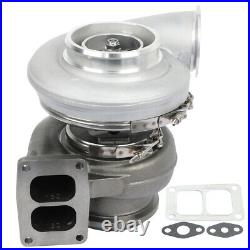
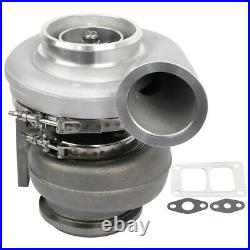
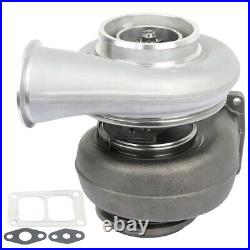
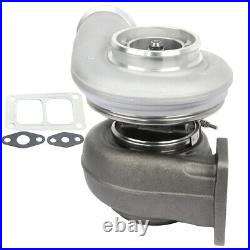
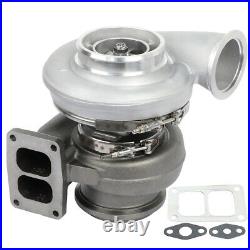
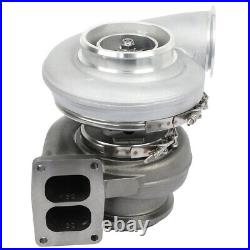
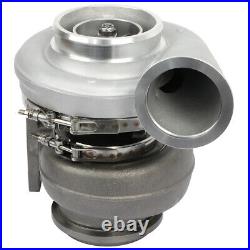
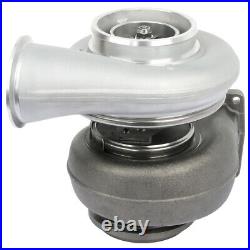
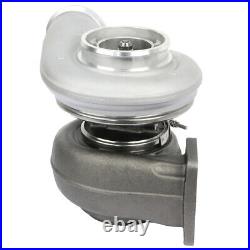
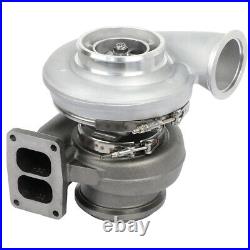
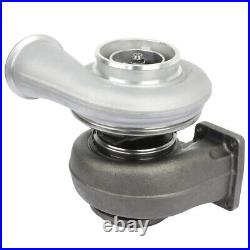

INITIAL INSPECTION AND GENERAL CARE. Carefully inspect the air cleaner, air cleaner duct, and the exhaust manifold for any foreign material. Objects left in these areas can severely damage the turbocharger immediately on engine startup. Remove old gaskets and left-over material from the exhaust manifold, the oil supply line and oil drain line flanges. Inspect these surfaces for cracks, flatness, or erosion. Inspect the oil supply and drain lines for degradation and cracking. Make sure that there are no kinks or any other type of restriction or clogging in either line. Turbo Charger for Detroit Diesel Series 60 12.7L for BorgWarner S400 1.32 A/R. Install the turbocharger, taking care to ensure that no dirt or foreign material enters the turbocharger openings. Always, use new gaskets and O-rings (where applicable). Do not connect the oil supply line or the air cleaner duct yet, see later steps. Pre-lube the turbocharger by pouring clean engine oil into the oil inlet hole of the turbo. With your fingers, spin the compressor wheel several times to coat the turbocharger bearings with oil. Pour more oil into the oil inlet hole to top it off. There may be some drainage, but this is of no concern. Connect the oil supply line and the air cleaner duct. Check for proper crankcase oil level. With the fuel shut off to prevent engine start, crank the engine for 10-15 seconds, or until the gauge shows an oil pressure build up. Start the engine and let it idle for 5-10 minutes. Do not rev the engine during this time. Check the installation for any oil leaks. The installation tips listed here are general guidelines that apply to all turbos and. Do not include vehicle-specific details. Refer to the authorized original equipment service manual for detailed installation instructions. If you do not have the experience, proper tools or manuals, please seek the services of a qualified technician. 6 Ways to Protect Your Turbo Engine. For the best performance from a turbocharger, change the oil at least every 5,000 miles. Warm Up the Engine. For the first 10 minutes of driving a cold car, go easy on the accelerator pedal to limit the strain on the oil pump and prevent unnecessary wear and tear on the turbo system. Wait at least 10 minutes before going full throttle, or watch the oil gauge for when it’s reached its optimum temperature. Don’t Overstep the Limits of the Turbo when Cruising. When cruising around town or on the motorway, try not to jab the accelerator. Instead, ease the power on slowly to give the turbo a chance to start spinning freely, and use the accelerator sparingly to maintain your speed. While turbos are rigorously stress-tested, and should last the lifetime of the engine, regular bouts of aggressive driving could take their toll, and cause costly issues. And remember – not only will gentle cruising spare your turbo, it’ll give you great fuel economy, too. Use Your Gears to Overtake. Whether you’re driving up a long hill, overtaking on an A road or accelerating into the fast lane on the motorway, downshifting into a lower gear is a safer long-term option than relying purely on the turbocharger. Gears were built for aiding performance up and down the rev range, so using a combination of gear changes and turbo boost will help to limit the wear and tear suffered through the turbo system. Let the Engine Cool After Driving. Turbos produce a lot of heat while driving, and if you turn off the engine straight away, this residual heat will boil the oil in the turbo system, leading to a build-up of carbon particles that can cause corrosion and premature engine wear. After driving, get in the habit of leaving the engine running for a couple of minutes at idle, which will cool the turbo enough to switch off the engine without cooking the engine oil. Don’t Blip the Throttle Before Turning the Engine Off. Whether you’re parking or simply want to hear the whizz of the turbo charger, don’t blip the throttle right before turning the ignition off. Pressing the accelerator causes the rotating turbines in the turbo to spin; when the engine is switched off, the flow of oil lubricating these moving parts will stop, but the turbines won’t stop spinning. This puts strain on the bearings, causing friction and a build-up of heat which can lead to a failure in the turbo system. You can reduce this risk by following the advice in point five – leaving the engine to cool before switching off the ignition. As the picture shows. OE Spec or Performance/Custom. Turbine Wheel OD (in). Comp Wheel Inducer (in). Turbine Wheel Exducer (in). 12.7L, 12700 ccm. There are NO EXCEPTIONS! OR, you may choose to have a replacement. FEEDBACK IS VERY IMPORTANT TO US. The note there will NOT be read. 1, We stand behind every product we sell. 3, We define the item as defective only if it doesn’t function as described. Mirror Glasses & Other Parts. Brake Rotors + Pads. Mass Air Flow Sensors. Air Cleaner Filter Boxes. Idle Air Control Valve. 4 pcs wheel hub bearing. Brake Pads & Brake Shoes. Wheel Hub Bearing Knuckle. Engine Timing Chain Kit. Engine Timing Belt Kit. ATV Rear Wheel Axle. Struts & Suspension Kit & Hubs. Protection Shield & Lift Kit. Adjustable Rear Control Arm. Metal heat shield sleeve. Brake Drums& Brake Shoes. Shift Knob Lever Head. Air Suspension Valve Solenoid. Transfer Case Shift Motor. (4) 1 Hubcentric 5×4.5 5×114.3 Wheel Spacers Fits Honda Accord Civic Acura RDX. (4) 2 Hubcentric 6×5.5 Wheel Spacers Fits Toyota 4Runner Tacoma Tundra Sequoia. (4) 2 Hubcentric Wheel Spacers 6×5.5 Fits Chevy Silverado Tahoe GMC Sierra 1500. (4) 1.5 Hubcentric 6×5.5 Wheel Spacers Fits Toyota Tacoma 4Runner Tundra Lexus. 20Pcs 12×1.25 Wheel Lug Bolts Shank 28mm For Chrysler 200 Dodge Dart Jeep Silver. Fits Toyota Highlander 2.4L 2001-06 Toyota Solara 2.4L 2002-07 Ignition Coil. New Turbocharger For Isuzu Rodeo 2.2L 3.2L 1998 1999 2001 2002 2003 8971397243.

